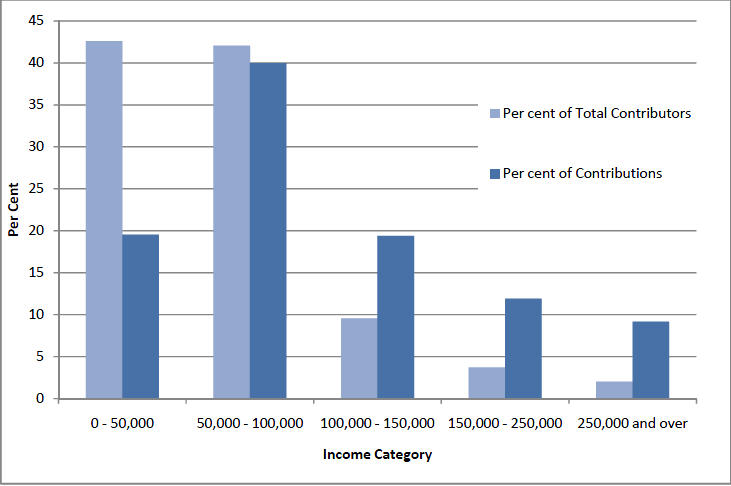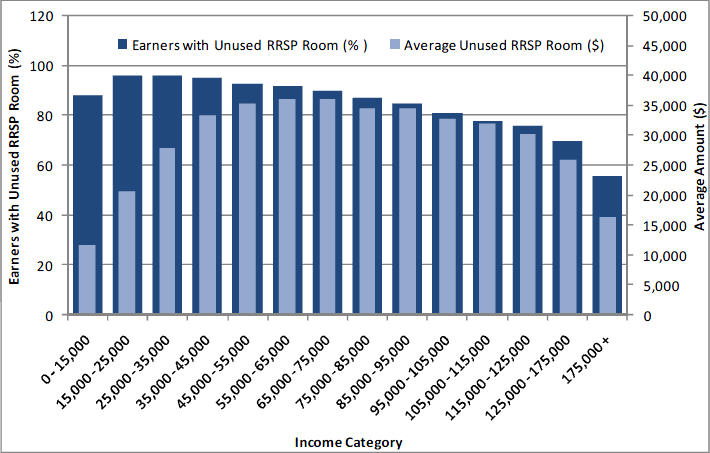Witnesses provided the Committee with their
views about the primary mechanism by which many Canadians voluntarily save for
their retirement in a tax-assisted manner—RRSPs—as well as about new mechanisms that might be implemented to
enhance voluntary retirement saving. With voluntary measures, Canadians often
make their own investment decisions, and better decisions are typically made
when the level of financial literacy is high; witnesses also provided their
views on literacy.
Figure 3: Total Contributions and Total Contributors to
Registered Retirement
Savings Plans, by Income Category, 2008 Taxation Year (%)

Source: Canada Revenue Agency, Income Statistics 2010—2008 tax year,
http://www.cra-arc.gc.ca/gncy/stts/gb08/pst/ntrm/pdf/table2-eng.pdf.
The BMO Financial Group’s Ms. Tina Di Vito
told the Committee that, in 2005, Canadians saved 1.2% of personal income, a
figure that had risen to 4.8% in 2008. She also indicated, however, that
Canadians are living longer, healthier lives, thereby giving rise to a need for
more saving to sustain them in what was characterized by her as a long and
active retirement. Ms. Di Vito also commented that: about 38% of Canadians
participate in an occupational pension plan, some of which are defined
contribution plans that involve a relatively greater burden for individuals in
terms of adequacy of saving and management of the investments; the costs of
care-giving are rising rapidly, giving rise to additional saving requirements to
meet their own needs as well as those of their parents; households headed by
baby boomers have more household debt than previous generations, with a
record-high level of household debt-to-income of about 145%; and the lifestyle
expectations of retirees are likely to exceed those of previous generations,
giving rise to a need for more retirement saving.
Ms. Di Vito also supported an increase in the
maximum contribution limit to RRSPs, questioning whether the current annual
limit is reasonable under the circumstances. She noted that, if RRSP
investments perform less well than expected, there is no ability to make
additional contributions to ensure that retirement is funded to the desired
level. In her opinion, the current limit also favours households, with a
dual-earner couple earning $75,000 each, for $150,000 in total, being able to
contribute $27,000 to their RRSPs and a single person earning $150,000 being
permitted to contribute $22,000. She argued for a contribution limit similar to
that of defined benefit pension plans.
Carleton University’s Mr. Ian Lee, who
appeared on his own behalf, identified annual limits on retirement saving as an
issue, and advocated a “levelling of the pension playing field” through the
creation of a common set of pension rules and replacement of the annual
contribution limit with an accumulated target, such as $1 million. Similarly
wishing to support equity, Mr. Scott Perkin, of the Association of Canadian
Pension Management, and Mr. Leslie Herr, of the Empire Life Insurance Company, urged
the adoption of a lifetime contribution limit in order to ensure greater parity
between those who save exclusively through an RRSP and those who are
occupational pension plan members. Mr. Terry Campbell, of the Canadian Bankers
Association, noted that while it is possible to carry forward unused RRSP contribution
room, it is tied to employment income; when you are younger, the contribution
room is lower. In Ms. Di Vito’s opinion, the ability to carry forward unused
contribution room is akin to a lifetime maximum contribution limit.
The annual RRSP contribution limit is based
on earned income, and Mr. Dean Connor, of the Canadian Life and
Health Insurance Association, advocated an expanded definition of “earned
income” to include such income sources as royalties and active business income.
In his view, such an expansion would benefit self-employed persons.
Figure 4: Earners with Unused Registered Retirement Savings
Plan Contribution
Room (%) and Average Amount of Unused Registered Retirement Savings Plan
Contribution Room, by Income Category, 2006

Source: Submission by the Department of Finance to the Standing
Senate Committee on Banking, Trade and Commerce, March 31, 2010.
Mr. Lee identified the trade-off that occurs
between retirement saving and other purchases, with specific mention made of
home ownership. In his view, the single largest asset for many Canadians is
their home, rather than their retirement saving. In Ms. Di Vito’s
opinion, however, Canadians are relatively reluctant to move out of their home
in old age; moreover, the amount of equity associated with the downsizing of a
home is often less than anticipated.
Some witnesses who commented on RRSPs also
spoke about registered retirement income funds (RRIFs), since contributions to
RRSPs must cease at age 71, and contributions and accumulated returns must be
used to purchase annuities or converted to RRIFs. For example, in recognizing
that Canadians live, work and save longer, and in implicitly supporting an end
to the practice whereby contributions to RRSPs must cease at age 71, Ms. Di
Vito also advocated flexibility for Canadians that would allow them to choose
when to begin withdrawing funds from their RRSPs.
In Ms. Di Vito’s view, flexibility should
also be given in respect of the mandatory minimum withdrawal rates from RRIFs.
In particular, she argued that the current prescribed withdrawal rates may
deplete RRIF funds too quickly, and advocated a reduction in the rate at which
funds must be withdrawn, which will extend the life of an RRIF. She commented
that withdrawal rates of 4% or 5% may be more sustainable.
Mr. Campbell, Mr. Herr and Mr. Connor
supported an increase in the age of conversion, with specific mention made of
an increase from 71 years to 73 years in order to allow those who are still
working to continue to save.
Witnesses also provided their views about a
range of other RRSP-related issues. For example, Ms. Di Vito suggested that
while RRSP contributions should be taxed as deferred employment income, the
investment returns generated by RRSP contributions should be taxed at a rate
that mimics the tax rate that would have been paid had the investments been
held outside a registered savings plan. For example, the investment returns
would be taxed as dividends and as capital gains, with preferential tax
treatment, rather than as interest income. In her view, the loss of preferred
tax status for dividend income and capital gains held in an RRSP affects
investment behaviour and may induce people to hold interest-bearing securities,
even if interest rates are relatively low.
Ms. Di Vito also commented that any balances
in RRSPs or RRIFs when individuals die should be permitted to be rolled over,
on a tax-free basis, into the next generation’s RRSP or RRIF. In her view,
ideally this rollover would be available in addition to any unused RRSP
contribution room. She also argued for a review of the 1995 Income Tax Act amendment that ended the ability to roll over a certain amount of severance
payments to an RRSP on a tax-free basis.
Neither Mr. Connor, nor Mr. John Farrell of
Federally Regulated Employers—Transportation and Communications (FETCO),
supported increases to OAS or GIS benefits; nor did they support increases to
the Canada/Quebec Pension Plan (C/QPP). Rather, they each endorsed some form of
a voluntary defined contribution supplement to the CPP. However, FETCO’s Mr. Ian Markham
warned that a voluntary CPP supplement, which would be on a defined
contribution basis, would redirect money that would otherwise have been contributed
to an RRSP. However, since RRSP investments are often made in relatively high-cost
investment vehicles, a voluntary supplement to the CPP could theoretically be
administered at a lower cost.
The Rotman International Centre for Pension
Management’s Mr. Keith Ambachtsheer, who appeared on his own behalf,
shared his view that Canadians do not, and probably will not, voluntarily
accumulate sufficient retirement saving; consequently, policy intervention is
needed. However, he had concerns about increasing mandatory contributions, and
referred to his proposal—discussed in the 2008 C.D. House Institute report The
Canada Supplementary Pension Plan—for a voluntary defined contribution
Canada Supplementary Pension Plan (CSPP); according to this proposal,
individuals would be automatically enrolled with pre-set contribution rates and
a target pension equivalent to a 60% post-employment earnings replacement rate.
The proposal included the ability to opt out, a number of annuitization
choices, and the ability to transfer RRSP assets into their CSPP personal
retirement savings account.
Mr. Connor was among the witnesses who spoke
to the Committee about the need for financial literacy. For example, he said
that education could improve the retirement savings habits of Canadians, and
advocated opportunities to enhance communication about the importance of
retirement saving, especially for younger Canadians who can establish lifetime
strategies that will ideally result in a financially secure future. Mr. Campbell
identified a need for enhanced financial literacy in respect of savings and
retirement planning, while Mr. Markham commented that many Canadians do not
understand how to invest their RRSPs, with the result that they tend to invest
in fairly high-cost vehicles and may make the wrong decisions. Mr. Herr noted
that Canadian consumers need to have easy access to accurate, timely and
understandable information designed to help them with their financial planning
needs. Finally, Mr. Ambachtsheer, argued that the average Canadian is not
well-versed in investment theory.